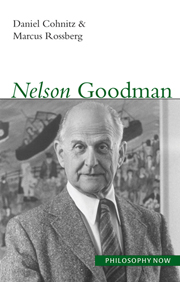Book contents
- Frontmatter
- Contents
- Acknowledgements
- Abbreviations
- 1 The worldmaker's universe
- 2 If this were an emerald it would be grue: problems and riddles of induction
- 3 The big picture
- 4 Particulars and parts
- 5 From Vienna Station to Boston Terminus
- 6 Follow the sign
- 7 Diagnosing art
- 8 Starmaking
- 9 Never mind mind, essence is not essential, and matter does not matter
- List of symbols
- Glossary of technical terms
- Further reading
- Notes
- Bibliography
- Index
1 - The worldmaker's universe
- Frontmatter
- Contents
- Acknowledgements
- Abbreviations
- 1 The worldmaker's universe
- 2 If this were an emerald it would be grue: problems and riddles of induction
- 3 The big picture
- 4 Particulars and parts
- 5 From Vienna Station to Boston Terminus
- 6 Follow the sign
- 7 Diagnosing art
- 8 Starmaking
- 9 Never mind mind, essence is not essential, and matter does not matter
- List of symbols
- Glossary of technical terms
- Further reading
- Notes
- Bibliography
- Index
Summary
The whole and its parts
Nelson Goodman was a philosopher of enormous breadth. He made important and highly original contributions to epistemology, logic and the philosophy of science, but is also a famous figure in the analytic philosophy of art and in metaphysics.
Unlike many other philosophers of the twentieth century, Goodman was not a puzzle-solver who wrote in an almost inaccessible technical style on unrelated highly specialized problems; on the contrary, he worked on the most fundamental problems, contributing original and provocative insights, and his writing was always brilliant in both precision and style. As his students and/or co-authors Catherine Elgin, Israel Scheffler and Robert Schwartz have remarked in retrospect, he:
delighted in making points in the most provocative way possible. There is some controversy over what is the most outrageous thing he ever said. Among the more obvious contenders are the repudiation of sets, the grue paradox, the contention that one wrong note disqualifies a performance as an instance of a musical work, and the claim that there are many worlds if any. In such remarks, Goodman threw down the gauntlet. If you disagree with one (or more) of the above, you need to show what is wrong with the argument that leads to it. All too frequently the initial irritation is compounded as we begin to appreciate the difficulty of evading his conclusions without begging the question, or committing ourselves to claims that seem even more dubious than his.
(Elgin et al. 1999: 207)- Type
- Chapter
- Information
- Nelson Goodman , pp. 1 - 27Publisher: Acumen PublishingPrint publication year: 2006



